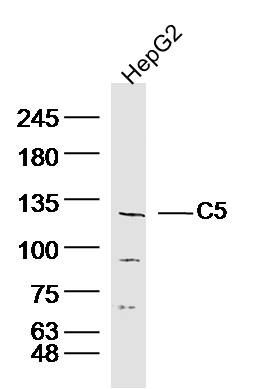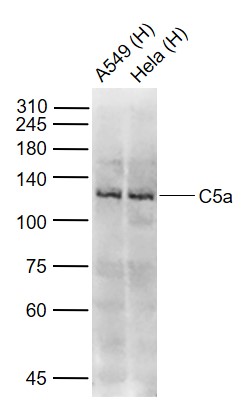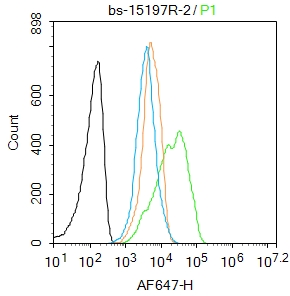
Rabbit Anti-C5a antibody
Anaphylatoxin C5a analog; C3 and PZP-like alpha-2-macroglobulin domain-containing protein 4; C5; CO5_HUMAN; Complement C5 alpha'' chain; Complement C5; Complement component C5; CPAMD4.
View History [Clear]
Details
Product Name C5a Chinese Name 补体C5a抗体 Alias Anaphylatoxin C5a analog; C3 and PZP-like alpha-2-macroglobulin domain-containing protein 4; C5; CO5_HUMAN; Complement C5 alpha'' chain; Complement C5; Complement component C5; CPAMD4. literatures Research Area Cell biology immunology The new supersedes the old Immunogen Species Rabbit Clonality Polyclonal React Species Human, (predicted: Mouse, Rat, ) Applications WB=1:500-2000 ELISA=1:5000-10000 Flow-Cyt=2ug/Test
not yet tested in other applications.
optimal dilutions/concentrations should be determined by the end user.Theoretical molecular weight 104/112kDa Cellular localization Secretory protein Form Liquid Concentration 1mg/ml immunogen KLH conjugated synthetic peptide derived from human Complement C5 alpha chain: 951-1100/1676 Lsotype IgG Purification affinity purified by Protein A Buffer Solution 0.01M TBS(pH7.4) with 1% BSA, 0.03% Proclin300 and 50% Glycerol. Storage Shipped at 4℃. Store at -20 °C for one year. Avoid repeated freeze/thaw cycles. Attention This product as supplied is intended for research use only, not for use in human, therapeutic or diagnostic applications. PubMed PubMed Product Detail The complement component proteins: C2, C3, C4 and C5 are potent anaphyl-atoxins that are released during complement activation. Binding of these proteins to their respective G protein-coupled receptors, C3aR, C1R and C5aR, induces proinflammatory events, such as cellular degranulation, smooth muscle contraction, arachidonic acid metabolism, cytokine release, leukocyte activation and cellular chemotaxis. Activation of the complement system leads to the formation of C5b-9 terminal complex, and while C5b-9 can promote cell lysis, the sublytic assembly of C5b-9 on plasma membranes causes an opposite result and induces cell cycle activation and survival. C5b-9 can rescue oligodendrocytes from FAS-mediated apoptosis by regulating caspase-8 processing via PI 3-K signaling. C5b-9 may play a pro-inflammatory role in the acute phase of multiple sclerosis, but may also be neuroprotective during the chronic phase of the disease. Complement C5 precursor contains C5a anaphylatoxin. C3a and C5a secretion correlates with pathophysiological phenotypes such as asthma and bacterial meningitis.
Function:
Activation of C5 by a C5 convertase initiates the spontaneous assembly of the late complement components, C5-C9, into the membrane attack complex. C5b has a transient binding site for C6. The C5b-C6 complex is the foundation upon which the lytic complex is assembled. Derived from proteolytic degradation of complement C5, C5 anaphylatoxin is a mediator of local inflammatory process. It induces the contraction of smooth muscle, increases vascular permeability and causes histamine release from mast cells and basophilic leukocytes. C5a also stimulates the locomotion of polymorphonuclear leukocytes (chemokinesis) and direct their migration toward sites of inflammation (chemotaxis).
Subunit:
C5 precursor is first processed by the removal of 4 basic residues, forming two chains, beta and alpha, linked by a disulfide bond. C5 convertase activates C5 by cleaving the alpha chain, releasing C5a anaphylatoxin and generating C5b (beta chain + alpha' chain). Interacts with tick complement inhibitor.
Subcellular Location:
Secreted.
DISEASE:
Defects in C5 are the cause of complement component 5 deficiency (C5D) [MIM:609536]. A rare defect of the complement classical pathway associated with susceptibility to severe recurrent infections, predominantly by Neisseria gonorrhoeae or Neisseria meningitidis. Note=An association study of C5 haplotypes and genotypes in individuals with chronic hepatitis C virus infection shows that individuals homozygous for the C5_1 haplotype have a significantly higher stage of liver fibrosis than individuals carrying at least 1 other allele (PubMed:15995705).
Similarity:
Contains 1 anaphylatoxin-like domain. Contains 1 NTR domain.
SWISS:
P02748
Gene ID:
727
Database links:Entrez Gene: 727 Human
Entrez Gene: 15139 Mouse
Omim: 120900 Human
SwissProt: P01031 Human
SwissProt: P06684 Mouse
Unigene: 494997 Human
Unigene: 2168 Mouse
Product Picture
Primary: Anti- C5 (SL15197R)at 1/300 dilution
Secondary: IRDye800CW Goat Anti-Rabbit IgG at 1/20000 dilution
Predicted band size: 104/112kD
Observed band size: 117kD
Sample:
Lane 1: A549 (Human) Cell Lysate at 30 ug
Lane 2: Hela (Human) Cell Lysate at 30 ug
Primary: Anti-C5a (SL15197R) at 1/1000 dilution
Secondary: IRDye800CW Goat Anti-Rabbit IgG at 1/20000 dilution
Predicted band size: 115/105 kD
Observed band size: 115 kD
Blank control: HepG2.
Primary Antibody (green line): Rabbit Anti-C5 antibody (SL15197R)
Dilution: 2μg /10^6 cells;
Isotype Control Antibody (orange line): Rabbit IgG .
Secondary Antibody : Goat anti-rabbit IgG-AF647
Dilution: 1μg /test.
Protocol
The cells were fixed with 4% PFA (10min at room temperature)and then permeabilized with 0.1% PBST for 20 min at room temperature. The cells were then incubated in 5%BSA to block non-specific protein-protein interactions for 30 min at room temperature .Cells stained with Primary Antibody for 30 min at room temperature. The secondary antibody used for 40 min at room temperature. Acquisition of 20,000 events was performed.
References (0)
No References
Bought notes(bought amounts latest0)
No one bought this product
User Comment(Total0User Comment Num)
- No comment





 +86 571 56623320
+86 571 56623320
 +86 18668110335
+86 18668110335

